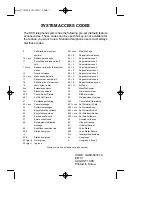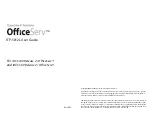
15
d. 4+2 Express Format
This DTMF format consists of a four digit account code, two digit message type, and a two digit event code.
Account Code
Message Type
XXXX 27 XX #20
Memory Location
Event Code
Enter 4+2 Express ID Settings Here:
27
#20
When the “
INFO
” button is pressed (
E-1600A-AST2EWP
or
E-1600A-BLT2EWP
only), the phone goes off-hook
and dials the first “
INFO
” phone number programmed. If a busy signal is detected or the call goes unanswered,
the phone will cycle through all three “
INFO
” phone numbers until the call is answered. When answered, handsfree
communication is established.
Note:
The voice announcement is for
Help
calls only and will not play on a call
initiated from the “
INFO
” button.
When the “
HELP
” / “
CALL
” button is pressed, the
1600A
series phone goes off-hook and dials a pre-programmed
telephone number. The Call Connected LED momentarily flashes during tone or pulse dialing. In the event the line
is busy or there is a ring-no-answer, the unit can be programmed to call additional phone numbers. The phone
then cycles through up to 5 pre-programmed emergency numbers until the call is answered. When the call is
answered, the digital voice announcer will automatically play to identify the location of the emergency call. The
phones are factory programmed to play the announcement once, and the automatically light the “Call Connected”
LED to show that handsfree communication to emergency personnel is established. The
Q
key will send the I.D.
number (if programmed), and play the announcement again. The distant party will know the location of the
emergency call by either the voice announcement or by decoding the touch tone I.D. number. Once the “Call
Connected” LED is on, the # key can be used to force the phone to hang up.
Operation
A. Standard Operation
1. “HELP” / “CALL” Button
2. “INFO” Button (E-1600A-AST2EWP / E-1600A-BLT2EWP only)
B. Central Station Operation
After the “
HELP
” / “
CALL
” button on the
1600A
Series phone has been pressed the
1600A
Series phone will begin to
dial. If a voice number is programmed in memory locations
#00-#04
, these numbers will be dialed first. Upon detecting
a busy signal or after a preprogrammed ring delay the
1600A
Series phone will hang-up and dial the central station
phone number stored in memory location
#05
. When the central station receiver answers, it will send a handshake
tone to the
1600A
phone. Upon detecting the handshake tone, the
1600A
Series phone will begin uploading the
information stored in memory location
#20
.
Once the
1600A
Series phone has sent the information stored in memory location
#20
, it waits for a “kiss-off” tone
from the central station. When the “kiss-off” tone is received, the phone turns on the call connected LED and goes into
the “two-way talk mode” or hangs up and dials position
#06
if programmed (see Note 3 below).
Notes:
1.
The central station should have a “talk-over” feature that will allow a two-way conversation at this time. If your receiver does not
support “talk-over”, a voice phone number should be programmed into position
#06
.
2.
If the central station answers the call, sends the handshake tone, but does not send a “kiss off” tone after the information is sent,
the
1600A
resends the information three additional times, waiting for a “kiss-off” after each attempt. If “kiss-off” has not been received
after the fourth attempt, the
1600A
hangs up and dials position
#05
again.
3.
The
1600A
has the capability to send a second informational message to the receiver after the first “kiss-off” is received, but only
if a second informational message is stored in memory location
#21
. After the first “kiss-off” is received, the
1600A
sends the
information stored in memory location
#21
. It then waits for a second “kiss-off” from the central station receiver. When the second
“kiss-off” is received, the phone turns on the call connected LED and goes into the “two-way talk mode” or hangs up and dials
position
#06
if programmed.


































